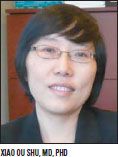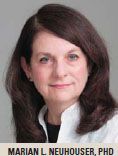Soy foods may reduce recurrence risk in breast cancer patients
Study in Asian population runs counter to previous concern that phytoestrogen in soy may increase disease risk.
Breast cancer patients can be assured that enjoying soy food products won't hurt them and may even impart some benefit for reducing the risk of recurrence. But when discussing the pros and cons of soy, clinicians should be aware that there are differences in the quantity and quality of soy in popular food products.
Soy is known to contain both estrogenlike and anti-estrogenic properties, and previous research has yielded conflicting results. A 2003 study suggested that the soy protein genistein may cause ER-positive tumors to grow faster while a 2006 meta-analysis of research on soy intake and breast cancer noted only a modest reduction in risk (Cancer Res 61:5045-5050; J Natl Cancer Inst 98:459-471).
A Second Opinion
"Can we be satisfied with prospective cohort studies?," said Donald I. Abrams, MD, president of the Society for Integrative Oncology. "Although we crave randomized, double-blind, placebo-controlled trials to generate incontrovertible evidence, such a study would be obviously impossible. We cannot assign a population to never consume soy foods. Placebo tofu definitely sounds unpalatable...most thought leaders conclude that soy foods are probably fine [for women with breast cancer]. Isoflavone supplementation is discouraged as they may be more potent phytoestrogens. Less processed soy products (edamame, soy milk, tofu, miso) are preferred over heavily processed soy items such as soy cheese, soy hot dogs, or soy turkey."
Excerpted from an editorial in the Journal of the Society for Integrative Oncology online, February 2010.
More recent studies have bolstered the benefits of soy (see Fact box), including the latest research from Xiao Ou Shu, MD, PhD, and colleagues. They studied the association of soy food consumption after a breast cancer diagnosis using data on 5,033 patients from the Shanghai Breast Cancer Survival Study. Dr. Shu is a professor of medicine in the division of epidemiology at Nashville's Vanderbilt University Medical Center and Vanderbilt- Ingram Cancer Center. Co-authors are from the Shanghai Institute of Preventive Medicine. Dr. Shu reported having received a research development fund from the United Soybean Board in 2005, according to JAMA.
Fact Studies in support of soy use by breast ca patients
The women were sent a structured questionnaire. The authors collected clinical information and assessed habitual dietary intake at various times over a 36- month period. A food frequency questionnaire measured the consumption of soy foods (tofu, soy milk, fresh soy beans) and other foods such as meat, fish, and cruciferous vegetables. As of June 2009, the 36-month interview was completed for 4,354 of 4,934 eligible patients. The major endpoints for the study were death from any cause, cancer recurrence or metastasis, or death from breast cancer (JAMA 302:2437-2443, 2009).
In the multivariate analysis, Dr. Shu's group adjusted for known clinical predictors and lifestyle factors related to soy intake and survival, including age at diagnosis, tumor stage, method of treatment (chemotherapy, radiotherapy, etc), hormone-receptor status, and tamoxifen use.
After a median follow up of 3.9 years, the authors documented 444 total deaths and 534 recurrences or breast cancerrelated deaths in the study group. They found that soy protein or soy isoflavone intake after cancer diagnosis was inversely associated with mortality and recurrence.
When comparing the hazard ratios for the highest and lowest quartiles of soy protein intake, the authors calculated HRs of 0.71 for total mortality and 0.68 for recurrence. The corresponding HRs for mortality when soy isoflavone intake was considered were 0.79 for mortality and 0.77 for recurrence. The multivariate-adjusted, four-year mortality rate for women in the lowest quartile was 10.3% while the recurrence rate was 11.2%. For women in the highest quartile, the multivariate-adjusted, four-year mortality rate was 7.4% and the recurrence rate was 8%.

Hormone-receptor status did not change the association between soy consumption, mortality, and recurrence, the authors reported. Also, the regular use of soy products did not confer additional benefits in women who were also on tamoxifen. However, women on tamoxifen with low to moderate soy intake did see an improvement in survival, the authors said, suggesting that "high soy food intake and tamoxifen use may have a comparable effect on breast cancer outcomes."
However, Dr. Shu told Oncology News International that "it would be premature to recommend that women replace tamoxifen with soy food. In our observational study, we found the soy food consumption has [a] similar effect on breast cancer outcome [to] tamoxifen. [But] a definite answer will have to come from controlled clinical trials."
As for how much intake is needed to reap the benefits of soy, in the Shanghai study 50% of women consumed soy foods that are the equivalent of 9.45 g of soy protein per day. Based on a dose-response pattern, Dr. Shu's group determined that the association of soy food intake with mortality and recurrence topped out at 11 g of soy protein/day. No additional benefits were seen with more than 11 g of soy protein/day, they wrote.
The authors acknowledged that the study had several limitations. First, women with a higher soy intake engaged in a healthier lifestyle overall, including more exercise and a high vegetable intake. Also, the follow-up period was relatively short and the study did not have enough statistical power for a subanalysis by estrogen-receptor or tamoxifen status. Dr. Shu said that her group will continue with this research, looking specifically at subgroup analysis by ER status and tamoxifen use.
Vantage Point
Pass the Pad Thai-with a side of more research on soy

This study has a number of strengths, including detailed data on treatment, clinical characteristics, and lifestyle and diet habits, wrote Dr. Neuhouser and co-author Rachel Ballard-Barbash, MD, MPH.
"Patients with breast cancer can be assured that enjoying a soy latte or indulging in Pad Thai with tofu causes no harm and, when consumed in plentiful amounts, may reduce risk of disease recurrence," they said. Dr. Neuhouser is from Seattle's Fred Hutchinson Cancer Research Center. Dr. Ballard-Barbash is from the NCI's division of cancer control and population sciences in Bethesda, Md.
But they warned that clinicians need to keep in mind that not all soy is created equal: Asian populations generally consume more whole-soy products such as tofu and soy milk. In comparison, soy supplements, or products infused with soy, are more commonly eaten in the U.S. and these foods may not contain beneficial isoflavone levels.
"Studies in larger cohorts are required to understand the effects of these foods among diverse clinical subgroups of breast cancer patients and survivors," they said. Finally, they pointed out that Dr. Shu's group did not describe the initial diagnosis and treatment process in China, which may make a difference in terms of survival times compared with U.S. practices (JAMA 302:2483-2484, 2009).